
Back واغاشي Arabic Wagashi Catalan Wagaši Czech Wagashi Danish Japanische Süßigkeiten German Japana dolĉaĵo Esperanto Wagashi Spanish واگاشی Persian Wagashi Finnish Wagashi French
 Nerikiri (練り切り) in various shapes and colors. Asian skunk cabbage, rose of Sharon, hydrangea, and rose. | |
| Type | Confectionery |
|---|---|
| Place of origin | Japan |
Wagashi (和菓子, wa-gashi) is a traditional Japanese confection that is often served with green tea, especially the type made of mochi, anko (azuki bean paste), and fruit. Wagashi is typically made from plant-based ingredients with an emphasis on seasonality, and generally making use of cooking methods that pre-date Western influence in Japan.[1]
Most of today's wagashi were born during the Edo period (1603-1868). This was a period of peace, economic and cultural prosperity, and increased domestic self-sufficiency in sugar.[2][3][4] During the Edo period, a series of delicate and beautiful fresh wagashi called nerikiri (練り切り) were created with various shapes and colors that characterize wagashi. Nerikiri are wagashi made by kneading white bean paste, gyūhi, sugar, yams, and other ingredients, and made in various colors and shapes based on seasonal flowers, animals, nature, events, customs, and other themes.[2][5]
- ^ Harrison, Thom (2021). "What is 'Wagashi'?". Wagashi UK. Retrieved 25 April 2023.
- ^ a b 和菓子の歴史 (in Japanese). Ministry of Agriculture, Forestry and Fisheries (Japan). Archived from the original on 22 February 2024. Retrieved 22 February 2024.
- ^ 駆け足でたどる和菓子の歴史 (in Japanese). National Diet Library. Archived from the original on 22 February 2024. Retrieved 22 February 2024.
- ^ その1和菓子の歴史 (in Japanese). Japan Wagashi Association. Archived from the original on 22 February 2024. Retrieved 22 February 2024.
- ^ 練り切り (in Japanese). Digitalio, Inc. Archived from the original on 4 March 2016. Retrieved 23 February 2024.
© MMXXIII Rich X Search. We shall prevail. All rights reserved. Rich X Search